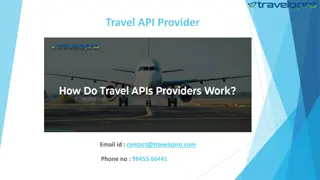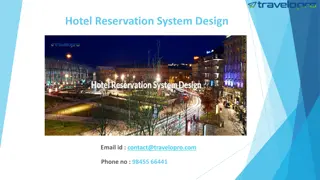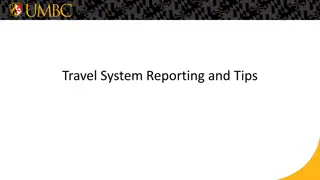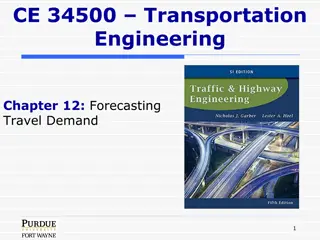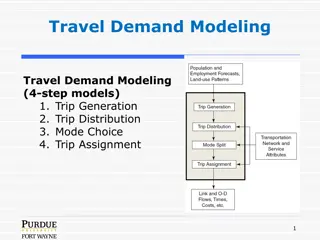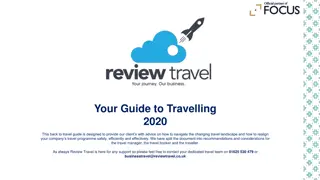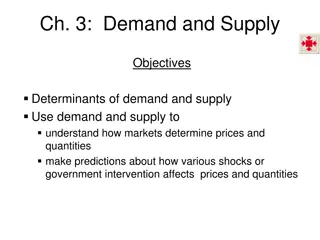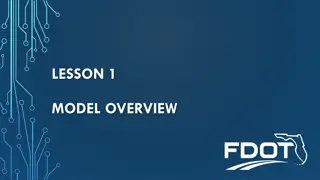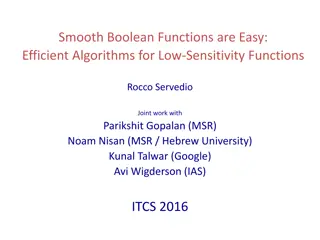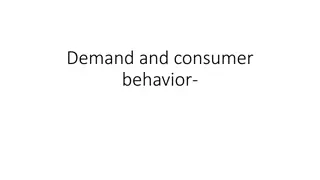Exploring Complexity and Complicatedness in Travel Demand Modeling Systems
Delve into the intricate world of travel demand modeling systems, where complexity arises from dynamic feedback, stochastic effects, uncertainty, and system structure. Discover the balance needed to minimize complicatedness while maximizing behavioral complexity in regional travel modeling. Uncover the importance of strong theoretical frameworks and thoughtful software design in creating effective model systems.
Download Presentation

Please find below an Image/Link to download the presentation.
The content on the website is provided AS IS for your information and personal use only. It may not be sold, licensed, or shared on other websites without obtaining consent from the author. Download presentation by click this link. If you encounter any issues during the download, it is possible that the publisher has removed the file from their server.
E N D
Presentation Transcript
GTAModel V5 Workshop September 20, 2023 1
Agenda Some basic principles. Overall model structure. TASHA core. Network modelling. Population & employment synthesis. Mid/long-term mobility decisions. Daily activity/travel demand. Other issues. Staff/schedule. 2
GTAModel V4 GTAModel V4 is now in operational use, or in the process of being implemented in: Almost all GTHA agencies. Region of Niagara. ARTM, Montreal. JRTA, Halifax. Monterrey, Mexico. Research-based transfers have also occurred in: Changzhou, China (Southeastern University). London, UK (Imperial College). Melbourne, Australia (Monash University). Sydney, Australia (UNSW). Temuco, Chile (University of Concepcion). Asuncion, Paraguay (UofT TMG). Cape Town, South Africa (UofT TMG). Latest version, V4.2, is being applied to a project for the TTC. 3
GTAModel V5 While we will continue to support operational V4 implementations and incremental upgrades, we want the next release to be a significant upgrade to a Version 5 of the model system that: Builds upon and incorporates all the lessons learned with V4. Is able to deal with the post-pandemic new normal . Hybrid work environment. In-home/virtual activity participation. New mobility systems. Is: Behaviourally sound. Policy-sensitive. Computationally efficient. Easy to use. Flexible & extensible to support continuing evolution. 4
Basic Principles Activity- & agent-based microsimulation. Complexity vs. complicatedness. Overall model system structure. The TASHA core. 5
Complexity vs. Complicatedness (1) From a complex systems perspective, complexity refers to behaviour. Complex behaviour arises from various combinations of: Dynamic feedback. Stochastic effects. Uncertainty. Complicated structure. Complicatedness refers to the intricacy of system structure. Travel behaviour and transportation system performance are both behaviourally complex and structurally complicated. 6
Complexity & Complicatedness (2) Regional travel demand model systems are examples of aggregate complexity systems. Their many components & sub-components make understanding how the system works and what the model outputs will be given inputs difficult. A major challenge in model system design is to keep the system as simple as possible (minimize complicatedness) while maximizing its ability to generate behavioural complexity. I would argue that most commercial model systems are overly complicated and insufficiently behaviourally complex. To reverse this situation, requires both: Strong, parsimonious theory. Careful software design. 7
Complexity & Complicatedness (3) Initial Network Assignment An important strategy for effective complex systems modelling is hierarchical modularity, combined with encapsulation. Hierarchical modularity: Break the system down into well defined modules. Load LoS Data Compute Access Station Models Compute Aggregate PoRPoW Compute Aggregate PoRPoS Hierarchically related. Keep logically separate processes separate: don t overload any single module. Load Household Well defined interfaces. Encapsulation: Assign Work/School Zones Assign Driver Licenses Assign Cars to Household The workings within each module are self- contained and don t depend on other modules. TASHA Interaction between modules is only through their interfaces (inputs & outputs). Applies to both theoretical specifications & programming implementation. Arguably most existing software (including, occasionally our own!) is overly monolithic , making model evolution difficult or even impossible. Mode Choice External Model Network Assignment Airport Model Compute Next Iteration Freight Model 8
Overall Model System Structure (1) All so-called activity-based model systems have the same overall model system structure. What differs is: Boundaries between major boxes. What goes inside the box . TAZ Pop & Emp Forecast Population Synthesis Mid/Long-Term Decisions Network Scenario Daily Activity/Travel Demand Network Assignment No Yes Equilibrium ? Output Results 9
Overall Model System Structure (2) Static, one-step forecast for a future year. Requires exogenous forecast of total population and employment by TAZ for the forecast year. Individual agents (persons and, possibly, households) are statistically synthesized with individual attributes. TAZ Pop & Emp Forecast Population Synthesis How is employment handled? Three major behavioural components: Mid/Long-Term Decisions Network Scenario Daily Activity/Travel Demand Mid/long-term decisions that condition daily activity & travel. Network Assignment Modelling typical ( average ) weekday demand for activity & travel. Yes No Assigning trips by mode to the transportation network. Equilibrium ? Output Results Determines modal LOS by link & O-Ds. Route (path) choice equilibrium assumed given input O-Ds. Equilibrium is imposed between travel demand and network LOS. 10 This overall model structure will be retained in V5.
Overall Model System Structure (3) T = 0 TAZ Pop & Emp Forecast Base Year Persons, Jobs, etc. Population Synthesis T = T+1 Mid/Long-Term Decisions Demographic Update Network Scenario Daily Activity/Travel Demand Employment Update Network Assignment Labour Force (PoRPoW) Update School Participation Update Network Scenario Yes No Equilibrium ? Output Results Mobility Tool Update Daily Activity/Travel Demand Note that the upper 3 boxes are the static replacement for a dynamic, evolutionary integrated land use transport model system. Network Assignment Yes No T = Output Results Forecast Year? We are NOT proposing an ILUTE-like model system for V5! But, we want our V5 models to be, as much as possible, static placeholders for an eventually more dynamic system. 11
The TASHA Core Generally, the greatest difference among model systems is how they model daily activity/travel demand. In GTAModel, we use TASHA (Travel/Activity Scheduler for Household Agents). TASHA is a true activity scheduling procedure, which generates out-of-home activity episodes for each person & household for the simulated day. It is explicitly household-based. It works in continuous time over a 24-hour weekday time period. A distinguishing feature of TASHA is that it is project-based: activity episodes are generated within projects to achieve project goals. The basic structure of TASHA will be retained in V5, but a number of improvements will be introduced in model specifications & interactions. 12
For every household h: Generate household h activity episodes For each person p in household h: Generate person p individual episodes (including locations for NWS episodes) Schedule person p s individual & household episodes & trips Tour-based mode choice for person p Assign household cars to drivers Assign drivers & passengers to intra-household rideshare trips
Activity Generation & Scheduling in TASHA TASHA generates the number of activity episodes from a set of projects that a person (or household) might engage in during a typical weekday. It also generates the desired start time and duration of each episode. It then builds each person s daily schedule, adjusting start times and durations to ensure feasibility. Travel episodes are inserted as part of the scheduling process. Activity Episode Frequency, Start Time and Duration Generation (c) Draw activity Duration from feasible region in joint PDF (a) Draw activity frequency from marginal PDF (b) Draw activity start time from feasible region in joint PDF Joint PDF Joint PDF Activity Frequency Start Time PDF Start Time Duration Activity Frequency Feasible Start Times Feasible Durations Scheduling Activity Episodes into a Daily Schedule Work Project Work School Project Other Project Other Shopping Project : : Shop 1 Shop 2 Person Schedule At-home Work At Home Other Shop 1 Other At-home Shop 2 At-home = Travel Episode = Activity Episode = Gap in Project Agenda
Tour-Based Mode Choice (Multinomial Probit Model) Structure of the TASHA TBMC will be unchanged in V5. Representation of ridehailing mode, among others will be improved. Chain c: 1. Home-Work 2. Work-Lunch 3. Lunch-Meeting 4. Meeting-Work 5. Work-Home mN = mode chosen for trip N Drive Option for Chain c Non-drive options for Chain c m1 = drive Sub-Chain s: 2. Work-Lunch 3. Lunch-Meeting 4. Meeting-Work m5 m4 m3 m2 m1 Drive for Sub-chain s Non-drive for Sub-chain s TASHA s tour-based mode choice model: Handles arbitrarily complex tours and sub-tours without needing to pre- specify the tours. Dynamically determines feasible combinations of modes available to use on tours. Modes can be added without changing the model structure. Cars automatically are used on all trips of a drive tour. m2 = drive m3 = drive m4 = drive m4 m3 m2 m5 = drive
Network Assignment (1) We have always used Emme as our network modelling software for road & transit assignment (since 1988!). Recently, interfaces to Aimsun & Visum have been developed. V5: We continue to use Emme as our standard network modelling software, with extensions to Aimsun & Visum as needed. STATIC EQUILIBRIUM ASSIGNMENT! (aka Deterministic User Equilibrium, DUE) Computationally efficient. Multi-decade experience/investment within the region. OK for many/most longer-range, strategic planning purposes. We recognize that some agencies are experimenting with DTA (Aimsun- mesoscopic; Dynameq). We are also interested in MATSim. DTA vs. DUE is actually not critical to V5 design. Is largely a computational issue, although other issues exist: Future year data inputs. Precision needed for strategic planning. Arguably a more micro/dynamic representation of transit is often more needed than road DTA. Continuing discussion & research is required, but can proceed in parallel to V5.0 development. 16
Network Assignment (2) The ARTM implementation involves implementation of Emme s Space-Time Traffic Assignment (STTA) algorithm for doing one-hour road assignments that provide a quasi- dynamic modeling of traffic flow. Arguably a nice compromise between conventional static & dynamic assignment procedures. We have developed a somewhat equivalent module for doing one-hour transit assignments. This replaces the V4 assignments of representative single-hour assignments per time period. This is computationally more intensive, but should yield improved representation of modal LOS over time over the day. If works well, will be adopted in V5. 17
Population & Employment Synthesis 18
Population Synthesis (1) Population synthesis is a relatively well understood problem. Various implementations of V4 use different population synthesizers: Simple cloning fi TTS records. PopSyn3 (WSP product). MetroPop (developed by Metrolinx). Other options include: PopulationSim: Updated version of PopSyn3. Open source, much more computationally efficient. New custom package. G5 should be able to interface with any synthesizer that meets its design specs: Generates a list of synthetic persons with attributes required by TASHA. Each person is attached to a synthetic household with attributes required by TASHA. On the other hand, it would be good to have a population synthesizer that is readily transportable to other urban areas. 19
Population Synthesis (2): MetroPop The default option for G5 is MetroPop. Sophisticated synthesizer. Fine-tuned for GGH. However: Data intensive. Highly integrated . I would like to investigate a simpler, more modular, easier to use approach. So, we ll see! Travel Modelling Group
Population Synthesis (3) Ideally, I would like to clearly differentiate between demographic synthesis (age, gender, etc.) and economic attributes (labour force participation, income, etc.). Keep it simple, efficient, statistical . Push all decisions into explicit, subsequent modules. Easy to change parameters, models. Potentially policy sensitive. Also behaviourally sound . Aside from MetroPop, V4 synthesis has always been based on TTS data. Probably a much more census-based approach should be adopted. Similar to GGH Model. 21
Population Synthesis (4): Person Attributes Minimum required: Age. Gender (male, female). Ethnicity.1 Recent immigrant (yes/no).1 Possibly? Education level.2 1. Not in V4. Will be supported by TTS 2022. Increasingly required for policy analysis. May or may not enter demand models. 2. Might be useful for determining labour force participation, occupation, etc. 22
Population Synthesis (5): Household Attributes Minimum required: Number of persons. Household type (single person, family w/o children, family w/ children, non-family, ?). The household is largely a container of persons (but it is an important agent in TASHA). Most household attributes are generated in subsequent modules. 23
Employment (Job) Synthesis Job synthesis is largely ignored (or at least not discussed) in many model systems. Generally individual jobs need be synthesized, but total employment per TAZ most be disaggregated into by occupation & employment status (full/part-time) for assignment to workers. In V4, this is done by simply applying observed base year (TTS) rates. This could be replaced by base year Census rates if we go to a more Census- based model. In forecasting, these rates could be replaced by assumed future year scenario rates. It is our impression that this is rarely, if ever done. At this time, we are not proposing to do anything different for V5. But, happy to discuss options. I am including this module here under synthesis (as opposed to labour market modelling , see upcoming slides), but this could be debated. 24
Mid/Long-Term Mobility Decisions 25
Mid/Long-Term Mobility Decisions Labour market: Labour force participation.1 WaH.1 PoRPoW. Income.1 Education: Student status.1 PoRPoS. Mobility tools: Driver s license. Household auto ownership. Mobility memberships (carshare? Bikeshare? )2 1. Currently in population synthesis. 2. Not currently in GTAModel. 26
Labour Market Participation Assign to each person 16+ years old: Employment status: Full-time employed. Part-time employed. Not employed. Occupation category, given empstat. Note: new occupations in TTS 2022! Currently part of population synthesis. Move it out into its own module. 27
Work at Home (WaH) (1) A major issue in post-pandemic travel modelling is dealing with the new hybrid work environment. Key definitions required to begin to address this issue: Work at Home (WaH): The worker does not have an out-of-home workplace. Self-employed. Employed by a company but: Has no office working all the time from home. May nominally have an office but never uses it.1 Work from Home (WfH): The worker has a place of employment outside the home, but on the simulated day s/he works from home and does not commute to the workplace. This terminology hopefully helps clarify different behaviours and is arguably better than the traditional term telecommuting , which does not (usually) differentiate well between the two options. 1. This may be better included in WfH with zero days commuting to the workplace? 28
WaH (2) WaH logically belongs within the mid/long term labour market component of the model system, since it does not change on a day- to-day basis. WaH has always been included in the GTAModel model systems, but, without adequate differentiation from WfH. V4: Part of population synthesis. Simple rates. V5: Pull out as a separate module to facilitate model upgrades and scenario testing. Keep rate-based model. Investigate improving categorization. 29
Place of Residence Place of Work (PoRPoW) Assigns specific workplaces (TAZ) to each worker based on worker employment status & occupation. V5: Keep the basic V4 approach (doubly-constrained entropy/gravity model). Can the explanatory variables be improved? Income? Inclusion of external jobs/workers within the model. Enhanced spatial structure effects: Central Place Theory concepts. Regional structure. 30
Auto Ownership EVs. Much work going on in this area; will incorporate. Have a PhD student working on this (Mwendwa Kiko). AVs: Not in V5.0. Privately-owned Avs represent a major change in activity/travel modelling. AV-based ridesharing is easy to handle if we have implemented the ridehailing model. 31
Daily Activity/Travel Demand: TASHA2 32
Key Issues to Address in TASHA2 1. Improved feedback between TASHA modules. 2. Incorporating new mobility services. 3. Modelling WfH/hybrid work. 4. Many others: 1. Virtual/in-home activities. 2. Modelling spatial choice. 3. Active transportation. 33
Feedback within TASHA The current TASHA activity episode generation & scheduling components are very sequential in design, with little feedback. As a result: Activity episode generation is quite inelastic. Some inconsistencies between calculations in different modules can occur. More interactions between generation, scheduling, mode choice and NWS location choice are required. Also need to deal better with: Supervision, etc. of dependents (e.g., children). WfH effects. These are the oldest parts of the software & have not been touched in a long while. In V5 we will open up the box to improve these interactions & update the code. Will need to experiment with alternative structures. Iteration within TASHA. Gibbs Sampling? 34
Incorporating Mobility Services PhD student Shuoyan Xu will be implementing a model of ridehailing service/performance in V5, based on Francisco Calder n s prototype. We have access to City of Toronto VfH data to support this work (plus TTS & THATS data). Tour-based mode choice model will be updated accordingly. 35
WfH Major challenge! It is far from clear that we can continue modelling a single typical day . Do we need a multi-day model? Options include: Run 5 one-day models. Experimenting with week-long model. THATS survey will support both options. Feedback effects of WfH on: Activity generation? Auto ownership? PhD student Mohammad Haghighi is working on week-long modelling and can help with this work. 36
Other Issues 37
Expansion to the GGH! GTAModel has always been focused on the GTHA, with the remainder of the GGH being treated in a very aggregate, non-agent-based way as external zones. Although a version of the model has now been extended to the Region of Niagara. It would be good to extend V5 to cover the entire GGH. This, however, will be a heavy lift for the small TMG staff, at least in the short run. Perhaps we can second regional agency staff to help us with some of the data assembly, model testing, etc.? If we do take on the whole GGH, I want to explore some sort of hierarchical treatment of regions within the overall study area: E.g., Niagara, Waterloo, etc., while connected with the GTHA are also economic regions in their own right, with their own spatial-socio-economic structure. 38
Time-Series Analysis Pre-pandemic, the intent had been to use multiple TTS years to develop model parameters that were robust over time. The pandemic & its aftermath have called this approach into question. Instead, we will develop V5 based on 2022/23 data and compare parameters, etc. with V4. We will also run V4 on 2022/23 data to see where the key differences are. Have an undergrad student doing her 4th Year thesis on this (Grace Zhang). 39
Staff James Vaughan: Lead software designer & programmer. Model estimation & model system calibration lead. Jeff Mukuka: Network coding & assignment model estimation/calibration. General analysis assistance. Henry Waterhouse: General analysis assistance. Amit Sandhel: XTMF Programming. Postdoctoral Fellows, Ya Gao, Alex Dong, Usman Ahmad: Data preparation. Model estimation & testing. Graduate Students: Mohammad Haghighi: TASHA updates; 5-day modelling. Mwendwa Kiko: Auto ownership modelling. Shuoyan Xu: Ridehailing model. Undergraduate student (Grace Zhang): Comparison of pre- & post-pandemic travel behaviour. 40
Schedule Work will begin in earnest in November. Hopefully TTS 2022 data will be available. TMG staff will have some cycles to spare for this work by then. Postdocs will be on staff by then. And then we ll see how far we can get by the end of March. We have always expected this work to go into the 2024-25 work year. Will provide an update on progress and the work plan at the Dec. 6 workshop. 41
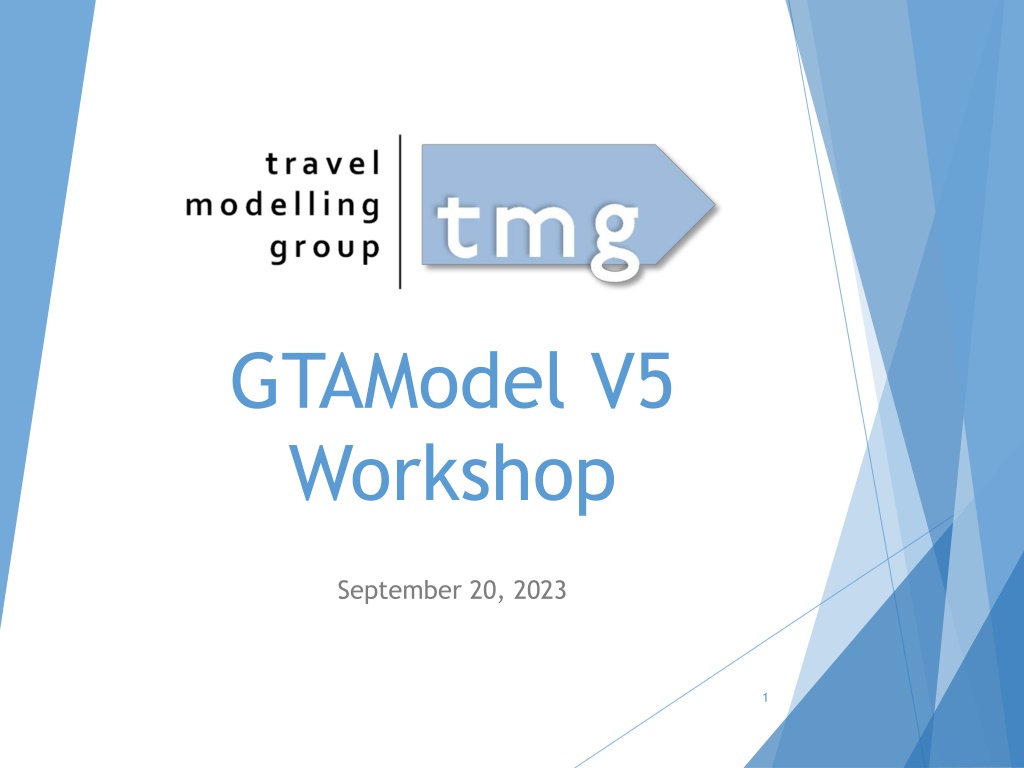
 undefined
undefined




